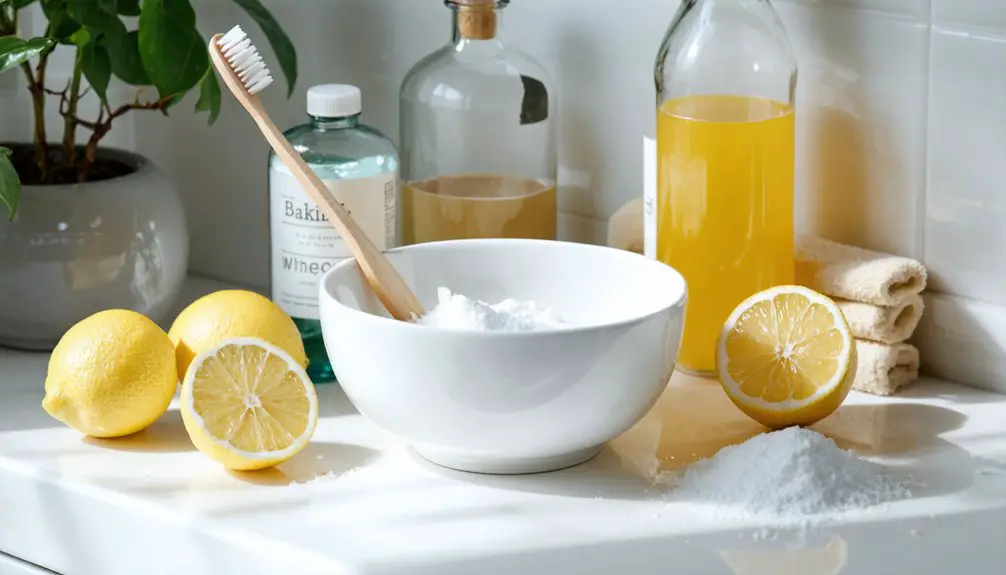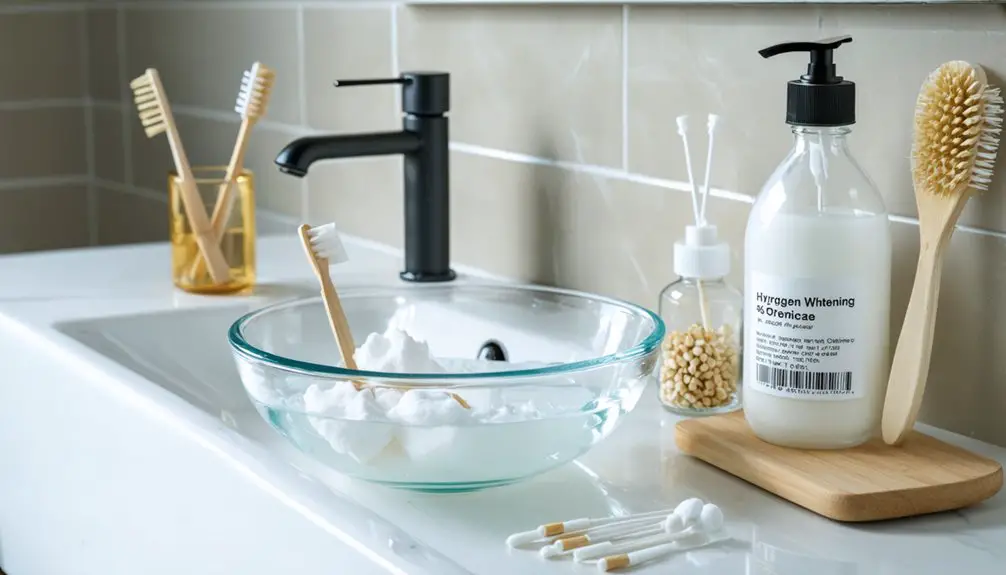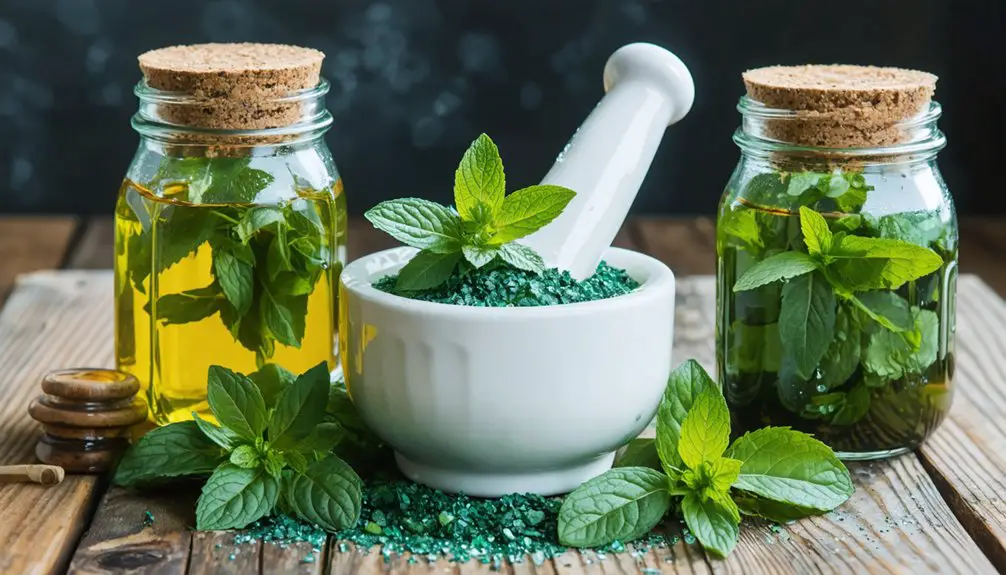You can safely whiten your teeth at home using common household items like baking soda, diluted hydrogen peroxide, and natural fruits. Start by combining 1 tablespoon baking soda with 2 tablespoons hydrogen peroxide to create a gentle whitening paste. Apply for 30-60 minutes daily, avoiding gum contact. Monitor for sensitivity and stop if irritation occurs. While these methods are effective, proper technique and precautions guarantee best results without damaging your enamel.
Key Takeaways
- Mix baking soda with 1.5% hydrogen peroxide to create a safe whitening paste for removing surface stains effectively.
- Apply mashed strawberries to teeth for 5 minutes, using their natural vitamin C and gentle bleaching properties.
- Practice oil pulling with coconut oil for 15-20 minutes daily to naturally whiten teeth and improve oral health.
- Use banana peel’s inner side against teeth for 2 minutes, as its minerals and compounds provide gentle whitening.
- Brush with a mixture of baking soda and water twice weekly to safely remove stains without damaging enamel.
Natural Ingredients for Teeth Whitening
While many natural ingredients offer potential teeth whitening effects, their effectiveness and safety profiles vary considerably.
You’ll find that banana peels contain beneficial compounds like alkaloids and flavonoids that may contribute to gentle whitening.
When considering acidic options, strawberry paste provides natural bleaching agents, though you’ll need to use it cautiously to protect your enamel.
Exercise extreme caution with lemon juice, as its highly acidic nature (pH 2-3) can severely damage tooth enamel despite its whitening properties. For safer results, dental supervision recommended helps prevent potential enamel damage from DIY whitening methods.
Instead, consider baking soda as a safer alternative – it’s a mild abrasive that effectively removes surface stains while neutralizing harmful acids. Research shows ficin and bromelain demonstrate excellent whitening potential comparable to traditional peroxide treatments.
When recommending natural whitening methods to others, always emphasize the importance of moderation and proper application techniques to prevent dental damage.
Safe Methods Using Kitchen Staples
Building on these natural whitening options, several common kitchen items offer safe and effective teeth whitening solutions when used properly.
Your safest approach combines gentle abrasives with antimicrobial ingredients to remove surface stains while protecting enamel integrity. The vitamin C content in fresh strawberries provides natural whitening properties. Diluting hydrogen peroxide to 1.5% concentration helps minimize potential gum irritation while still providing whitening benefits.
- Mix 1 tablespoon baking soda with 2 tablespoons hydrogen peroxide to create a whitening paste, monitoring for sensitivity during regular use.
- Practice coconut oil pulling by swishing 1 tablespoon for 15-20 minutes daily, disposing in trash to prevent drain clogs.
- Combine baking soda with coconut oil for a gentle homemade toothpaste that helps remove surface stains.
- Follow any natural whitening treatment with thorough rinsing and regular fluoride toothpaste to maintain oral health.
Always start gradually with these methods and discontinue if you experience discomfort or increased sensitivity.
Step-by-Step Home Whitening Process
Before starting a home teeth whitening regimen, it’s crucial to understand the proper step-by-step process to guarantee both safety and effectiveness.
When using home remedies, you’ll need to carefully prepare your whitening materials, whether they’re custom trays or over-the-counter products. A dental impression fitting ensures proper tray alignment for optimal results.
Apply your chosen whitening techniques precisely – place a small amount of gel in your tray or apply strips directly to your teeth, avoiding contact with gums.
You’ll want to wear the treatment for 30-60 minutes initially, adjusting based on sensitivity.
Optimal whitening results appear in two to four weeks with consistent daily use.
After removing the whitening agent, rinse thoroughly and avoid staining foods or beverages.
Monitor your progress regularly and watch for any adverse reactions.
If you experience persistent sensitivity, consult your dental professional for guidance on adjusting your treatment plan.
Preventive Care and Maintenance Tips
To maintain the results of your teeth whitening efforts, establishing proper preventive care habits is essential for long-term success. Your maintenance routines should focus on protecting your enamel while preventing new stains from developing.
- Brush twice daily with ADA-approved fluoride toothpaste, and don’t forget to replace your toothbrush every 3-4 months for ideal cleaning effectiveness.
- Limit your consumption of staining beverages like coffee, tea, and red wine; when you do consume them, rinse with water afterward.
- Include crunchy fruits and vegetables in your diet to naturally clean teeth, and incorporate calcium-rich dairy products to strengthen enamel. Consider snacking on apples, which have a crunchy cleaning action that helps remove plaque naturally. Try swishing with coconut oil for 15-20 minutes daily as an additional natural cleaning method.
- Schedule regular dental checkups and avoid tobacco products completely, as they’ll quickly reverse your whitening results and compromise oral health.
Remember to wait 30 minutes after consuming acidic foods before brushing to protect your enamel integrity.
When to Combine or Avoid DIY Methods
While DIY teeth whitening methods can be effective individually, combining multiple techniques requires careful consideration to prevent dental damage.
You’ll need to conduct a sensitivity assessment before mixing any whitening agents, and carefully monitor your teeth and gums for adverse reactions.
Never combine acidic ingredients with abrasives, as this can severely erode your enamel. If you’re using hydrogen peroxide and baking soda together, limit application frequency to once or twice weekly.
You should also space out different whitening methods rather than using them simultaneously. The rising popularity of DIY whitening trends has led to an increase in dental injuries from improper home treatments.
At Meader Family Dentistry, professional guidance can help determine the safest whitening approach for your specific dental needs.
Stop all whitening immediately if you experience pain, burning sensations, or gum irritation. Those with existing dental work, thin enamel, or receding gums should avoid combined treatments entirely.
Instead, stick to single, dentist-approved methods and maintain consistent oral hygiene practices.
Frequently Asked Questions
Can I Use These Methods if I Have Sensitive Teeth?
You’ll need extra caution with household sensitivity remedies. It’s best to consult your dentist first and use professionally approved dental care products designed specifically for sensitive teeth.
How Long Should I Wait Between Different Natural Whitening Treatments?
Like nurturing a delicate garden, space your natural whitening treatments 3-7 days apart. With sensitive teeth, you’ll want to extend timing recommendations to weekly intervals, monitoring your comfort between each treatment frequency.
Will These Methods Work on Artificial Teeth or Dental Crowns?
No, household whitening methods won’t effectively whiten artificial teeth or dental crowns. These materials don’t respond like natural enamel and can be damaged by DIY treatments. Consult your dentist for safe alternatives.
Can Children Use These Natural Teeth Whitening Methods Safely?
You’ll need to consult your child’s dentist first. While some natural methods like crunchy fruits are safe, children’s dental safety requires extra caution since their teeth are still developing.
Does Drinking Through a Straw Prevent Tooth Staining While Using Whitening Treatments?
Like a shield against staining storms, drinking through a straw offers partial protection during whitening treatments. You’ll reduce contact between beverages and teeth, but it’s not a foolproof solution for complete stain prevention.
References
- https://www.healthline.com/nutrition/whiten-teeth-naturally
- https://www.lwdentist.com/diy-teeth-whitening-what-works-and-what-to-avoid/
- https://www.signature-smile.com/home-treatments-to-naturally-whiten-your-teeth/
- https://mypenndentist.org/dental-tips/2024/02/29/safe-ways-to-whiten-teeth-naturally/
- https://www.urmc.rochester.edu/news/publications/health-matters/diy-teeth-whitening-too-good-to-be-true
- https://jamdsr.com/uploadfiles/25vol10issue1pp109-114.20220128072249.pdf
- https://www.todaysrdh.com/study-shows-natural-tooth-whiteners-as-effective-as-peroxide-whiteners/
- https://pmc.ncbi.nlm.nih.gov/articles/PMC10024105/
- https://pmc.ncbi.nlm.nih.gov/articles/PMC4058574/
- https://www.youtube.com/watch?v=6VxphLA7LD8



